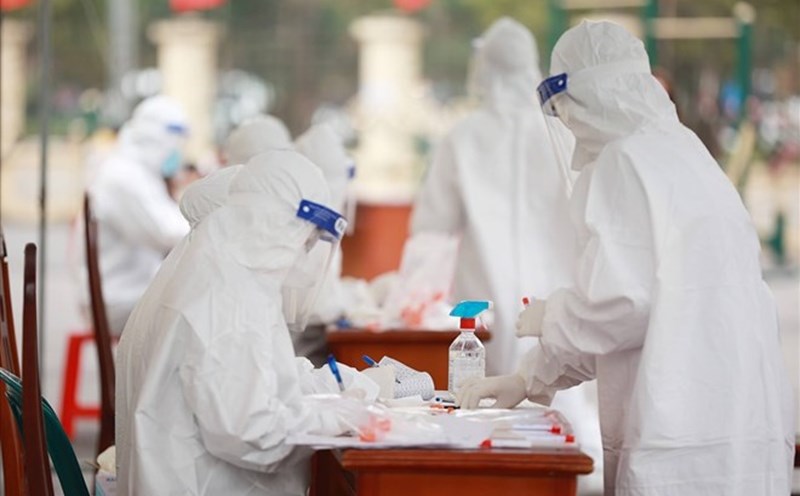COVID-19 patients increase slightly, medical facilities respond
Some countries such as Thailand have recorded an increase in the epidemic with more than 53,000 cases since the beginning of the year, mainly with mild symptoms. The outbreak in Thailand involves the sub- variant XBB.1.16, which is more likely to spread than Omicron but has not increased its toxicity.
According to the Hanoi Center for Disease Control (CDC), from January 1 to May 15, 2025, 38 cases of COVID-19 were recorded in 15/30 districts, with no complicated outbreaks, no serious cases or deaths. The number of cases is forecast to increase due to crowded events and tourism peak times.
In the past two weeks, many hospitals in Hanoi have recorded an increase in the number of COVID-19 cases, but most patients are at a mild level, not detecting a major outbreak.
At Thanh Nhan Hospital, from May 1 to 15, 12 cases of COVID-19 were received, of which 6 people were being treated as inpatients.
Duc Giang General Hospital also recorded scattered cases of COVID-19.
Hanoi Children's Hospital also recorded an increase in the number of children hospitalized due to COVID-19, about 20 cases per day since the beginning of May, mostly at a mild or moderate level. On May 19, 18 children were hospitalized. Hanoi Children's Hospital has completed facilities, isolation areas, equipment and medical supplies to be ready for admission, diagnosis, treatment and infection control. Respiratory infection prevention measures have been enhanced to minimize the risk of spreading in hospitals.
At the Central Hospital for Tropical Diseases, the number of new cases is still appearing everywhere every day, including some serious patients who need ventilators, but there have not been cases requiring ECMO intervention like in previous stages. The hospital maintains a separate quarantine area and clear traffic flow to avoid cross-infection, making it convenient to treat COVID-19 patients thanks to the specificity of the infectious disease department.
Director of Duc Giang General Hospital - Dr. Nguyen Van Thuong said that the unit clearly defines the criteria for hospitalization and outpatient treatment, and at the same time inspects materials and equipment to be ready to respond to all situations.
On May 19, the Department of Medical Examination and Treatment Management (Ministry of Health) requested hospitals and health departments to urgently update their plans for admission and treatment of COVID-19, and fully prepare isolation areas, equipment and consumables. Hospitals with resuscitation, cardiovascular, kidney, surgery departments... must ensure the safety of high-risk patients, while strengthening infection control and environmental sanitation.
Is COVID-19 quarantine necessary?
Associate Professor, Dr. Tran Dac Phu, former Director of the Department of Prevention and Control (Ministry of Health) said that COVID-19 is currently a group B circulating disease, developing in cycles like seasonal flu and not completely disappearing. The epidemic still occurs everywhere, with no recent recorded serious cases or deaths. The main variants are mild Omicron, but high-risk groups such as people with underlying diseases, immune deficiency and pregnant women are still susceptible to serious complications.
People should not worry too much but need to be vigilant, especially those with symptoms or close contacts who have to wear masks and wash their hands regularly. Medical facilities need to prepare hospital beds and isolation areas to respond promptly if the epidemic broke out.
The Ministry of Health closely monitors to promptly advise when new dangerous variants appear. COVID-19 is treated similar to seasonal flu, with mild cases being treated as outpatients, severe cases being hospitalized.
Outpatients need to be quarantined for at least 5 days, wear a mask for at least 10 days, limit contact and keep hygienic. Caregivers must also wear masks and strictly clean to prevent infection.
COVID-19 is transmitted through drops of fire, contact with surfaces and air in closed, crowded spaces. Symptoms are diverse, ranging from un indicated to severe such as pneumonia, respiratory failure, sepsis, and even death. High-risk groups include the elderly, severe underlying diseases, immunodeficiency, and pregnant women.
The Ministry of Health warns that the number of infections may continue to increase, recommends that people wear masks in public places, wash their hands regularly, eat and exercise regularly, and proactively check their health when they have symptoms of fever, cough, or difficulty breathing. People with underlying diseases, immunodeficiency or the elderly need to be more cautious.










